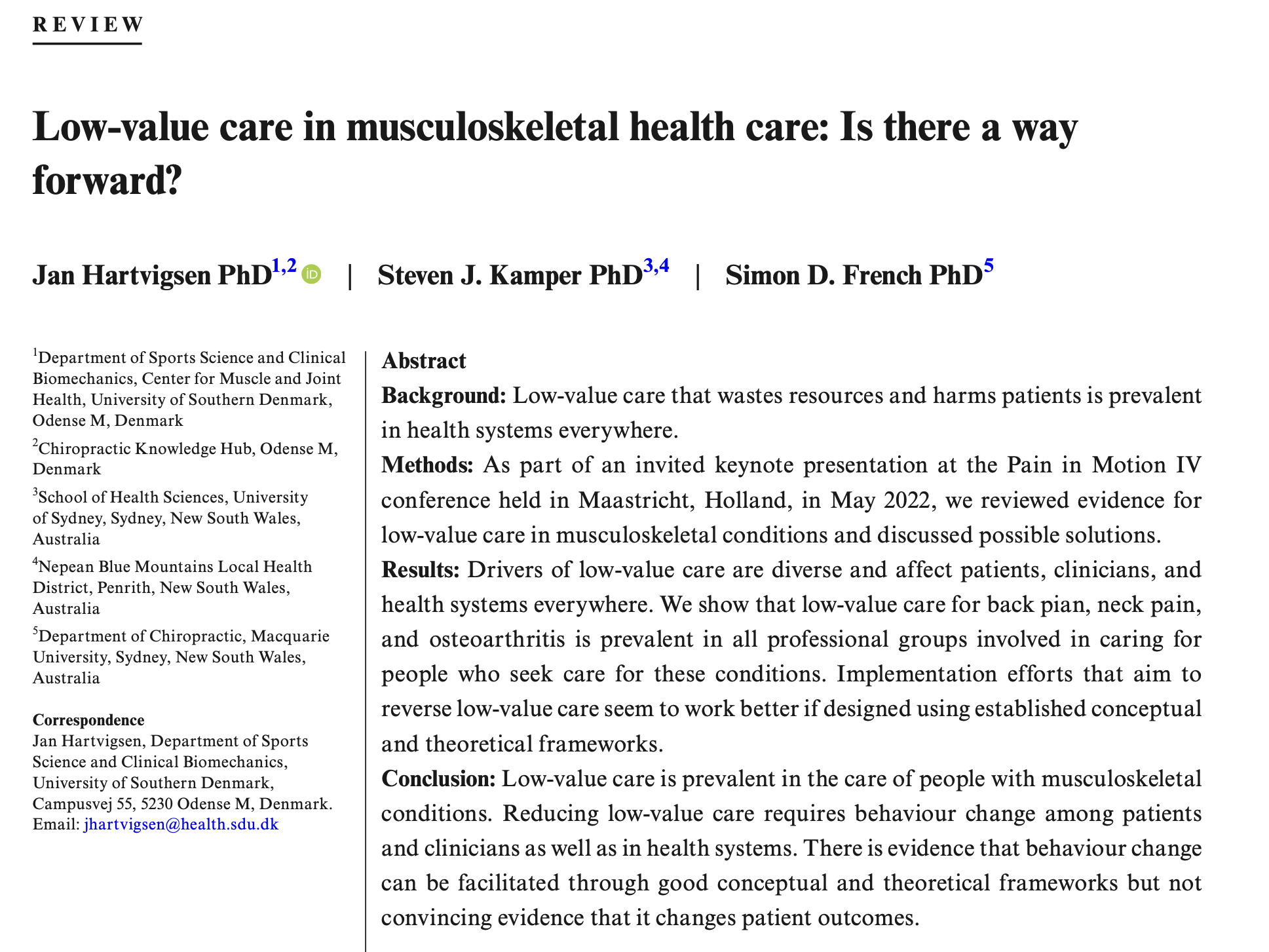Empty space, drag to resize
Last week’s
$12 bottle-of-wine analogy struck a chord—and a nerve. One reader asked:
Why raise prices when so much physio is still passive and unscientific? A totally fair question.
Here’s my short answer:
fees are only defensible when patients feel a clear, evidence-aligned difference in the process of care—when we tighten standards, cut out low-value practices, and collaborate across disciplines.

Let's talk about an elephant in the room. We know it's happening. We here it from our patient's. And we can sniff it out by surfing a website. Low value MSK care happens across all professions, but I want to keep the spotlight on physiotherapy.
There’s a difference between
physio mills (hot packs, TENS, and serial stretch tables) and
high-value practice (one-on-one time, active care, education, graded exposure, behaviour change, etc). Same profession—very different experience.
What story is the research telling?
- Low-value MSK care isn’t rare: roughly 60% of services align with best evidence, 30% are waste/duplication, and 10% are harmful (ref)
- Drivers include habits, incentives, defensive medicine, and clinic marketing—across all MSK professions, not just physio
So when we talk about raising fees, we’re stepping into a system where care quality is uneven almost by design. That tension unfortunately won’t resolve itself.


Do we have to wait for low-value care to disappear before raising prices?Not necessarily. Physio fees can rise in the short term—this is already happening. But long-term sustainability may depend on whether patients actually experience a different process of care: more active, more collaborative, more guideline-driven. At some point, payers may also start measuring outcomes and moving toward outcome-based pay, which will make quality care even more critical.
What does the data say about low versus high value care?
- More passive = more downstream medicalization. In a 4,827-patient U.S. cohort, each +10% shift toward passive visits was linked to 3–6% higher odds of an opioid Rx, spinal injection, or specialty referral within a year
- A +10% increase in the passive-to-active mix raised those odds 5–11%. Mechanical traction + multiple passive modalities had the worst profiles
- Adding manual therapy (with active care) looked better (e.g., ~50% lower injection odds; ~30% fewer specialty referrals). (ref)
- Following CPGs reduces costs. After implementing an LBP CPG in a large health system, downstream imaging, pharmacy, and surgery costs fell; direct PT costs dropped too (e.g., ~$2,863 vs ~$3,459 USD; p=0.05). Total downstream costs shrank markedly (~$4,636 vs ~$15,502; p=0.02). (ref)
- System-wide reality check. Persistent low-value care adds cost and harm and crowds out high-value options; replacing it requires behaviour change at patient, clinician, and system levels. (ref)
Translation: high-value care is not just clinically better—it’s financially smarter. Also, you can raise prices on optics—but durable trust, payer confidence, and profession-level credibility track to
process quality and
CPG-adherent,
active care.

Test raising your fees—not just as a business move, but as a
signal of your commitment to quality.
Communicate clearly with patients:
“We’ve adjusted our rates to match the time, training, and evidence-based care we deliver. What hasn’t changed is our commitment to practices that work, transparency about what doesn’t, and pathways to the right care when you need it.”This kind of framing does two things:
- Attracts and retains patients who value high-quality, science-driven care.
- Sets a line in the sand that your practice won’t rely on pseudoscientific or low-value modalities to justify price.

Don’t just raise your fees—
raise what patients can see.
Patients rarely read guidelines, but they can feel when their care is different: more one-on-one time, a plan that adapts with them, less dependence on machines or tables, and more agency in their own recovery. Making those differences
visible is how you turn a price into value.
Practical ideas:
- Show your process: display a “What quality physio looks like” poster in your clinic or website.
- Use contrast carefully: explain what you do (active care, education, collaboration) and why it matters, without shaming what you don’t do.
- Track and share wins: simple outcome measures, fewer unnecessary referrals, shorter wait times—these signal quality to both patients and payors.
By doing this, you don’t just protect the legitimacy of higher fees—you start building the case for future value-based payment models where quality, not volume, drives sustainability.

More money doesn’t always mean better care. But better care does deserve better reimbursement. The challenge for us is to flip the equation: fee alignment as the floor, high-value care as the ceiling.
Some patients like lots of passive care and it will actually help them. Not all passive care is bad, it is just knowing when something isn't working to realize this, and course correct.
Higher fees raise the stakes: maybe comparison becomes obvious, payers start to collect and scrutinize data, and transparent clinics differentiate on process and outcomes. The more we make quality visible (what we do, why we do it, how patients participate), the harder it is for low-value care to hide—and the fairer it is that quality practices aren’t punished for maintaining standards.
Empty space, drag to resize
Patients don’t need to become guideline experts. They just need to feel the difference: more time, reasoning, agency, appropriate hands-on, and a plan they own. That’s how price becomes value, not just a number—and how we protect physio from its lowest-value versions. What do you think? What other parts of the equation have we not discussed?






